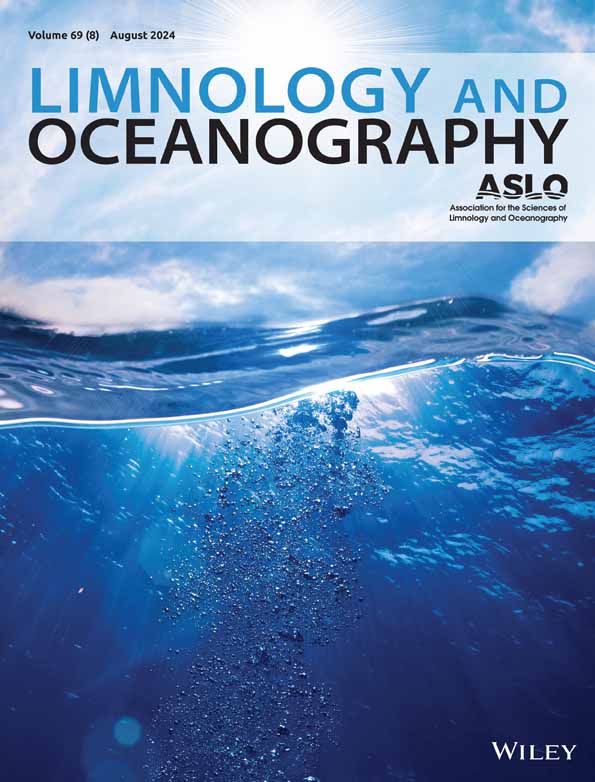浮游生物不在乎:海洋石灰化对东地中海浮游生物生长和放牧的最小影响
IF 3.7
1区 地球科学
Q1 LIMNOLOGY
引用次数: 0
摘要
二氧化碳排放量的增加导致了二氧化碳去除策略的发展,以抵消海洋酸化。其中,海洋碱度增强技术,特别是海洋石灰化,可能是恢复海水pH值和促进二氧化碳封存的一种有前途的方法。然而,石灰化对浮游生物群落的影响仍未得到充分探索。在中生态实验的框架下,我们进行了三次稀释培养,以评估天然浮游生物对石灰化的反应(丰度、组成、生长、放牧、饮食和食物选择性),并添加了氢氧化钙(Ca(OH)2)。试验包括低、高浓度石灰处理和不加Ca(OH)2的对照处理。该群落以小型浮游生物(细菌、聚藻球菌和色素微鞭毛藻)为主,数量超过较大的硅藻、鞭毛藻和纤毛虫。虽然叶绿素a、异养细菌和色素微鞭毛藻在不同处理下保持稳定,但聚藻球菌和鞭毛藻的丰度增加,而硅藻和纤毛藻在高Ca(OH)2条件下的丰度下降尤其明显。生长和放牧速率在很大程度上不受碱度的影响,除了着色的微鞭毛虫在石灰化后生长增加。微浮游动物对聚藻球菌和色素微鞭毛虫的摄取量较低,对硅藻、鞭毛虫和纤毛虫的摄取量较高。食物选择性对石灰化没有反应,因为食草动物根据大小选择猎物,而不考虑Ca(OH)2浓度。碱度和pH值的增加以及营养级联的平行效应可能驱动了营养波动并形成了下游的营养相互作用。尽管本研究强调了积极的反应,但在海洋碱度增强研究的框架下,需要进一步的研究来探索在更广泛的食物网成分和更大尺度上的石灰化潜力。本文章由计算机程序翻译,如有差异,请以英文原文为准。
Plankton do not care: Minimal effects of ocean liming on plankton growth and grazing in the Eastern Mediterranean
Increasing CO2 emissions have led to the development of CO2 removal strategies to counteract ocean acidification. Among these, ocean alkalinity enhancement techniques, particularly ocean liming, may represent a promising approach to restore seawater pH and boost CO2 sequestration. Yet, the impact of liming on plankton communities remains underexplored. In the framework of a mesocosm experiment, we conducted three dilution incubations to assess natural plankton response (abundance, composition, growth, grazing, diet, and food selectivity) to liming, achieved with calcium hydroxide (Ca(OH)2 ) additions. Experiments included two liming treatments (low concentration, and high concentration) and a control treatment without Ca(OH)2 . The community was dominated by small‐sized plankton (bacteria, Synechococcus and pigmented picoflagellates), outnumbering larger diatoms, dinoflagellates, and ciliates. While chlorophyll a , heterotrophic bacteria, and pigmented picoflagellates remained stable across treatments, the abundance of Synechococcus and dinoflagellates increased, whereas diatoms and ciliates declined particularly under high Ca(OH)2 . Growth and grazing rates were largely unaffected by alkalinity, except for increased growth in pigmented picoflagellates upon liming. Microzooplankton showed low ingestion of Synechococcus and pigmented picoflagellates and higher intake of diatoms, dinoflagellates, and ciliates. Food selectivity was unresponsive to liming, as the grazers selected prey based on size, regardless of Ca(OH)2 concentrations. Increased alkalinity and pH, and the parallel effect of trophic cascades might have driven nutrient fluctuations and shaped downstream trophic interactions. Despite positive responses highlighted in this study, further research is needed to explore liming potentiality on a wider range of food‐web components and larger scales in the framework of ocean alkalinity enhancement research.
求助全文
通过发布文献求助,成功后即可免费获取论文全文。
去求助
来源期刊

Limnology and Oceanography
地学-海洋学
CiteScore
8.80
自引率
6.70%
发文量
254
审稿时长
3 months
期刊介绍:
Limnology and Oceanography (L&O; print ISSN 0024-3590, online ISSN 1939-5590) publishes original articles, including scholarly reviews, about all aspects of limnology and oceanography. The journal''s unifying theme is the understanding of aquatic systems. Submissions are judged on the originality of their data, interpretations, and ideas, and on the degree to which they can be generalized beyond the particular aquatic system examined. Laboratory and modeling studies must demonstrate relevance to field environments; typically this means that they are bolstered by substantial "real-world" data. Few purely theoretical or purely empirical papers are accepted for review.
 求助内容:
求助内容: 应助结果提醒方式:
应助结果提醒方式:


